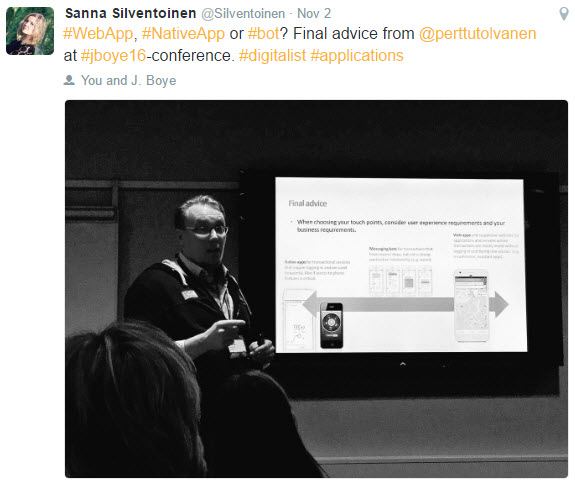Deciding your digital touch points is not always a straightforward task. Especially right now when the mobile world is developing at a fast pace. Many organizations have already invested big chunks of money in mobile apps, but many are still wondering about whether they should invest in high-quality web apps or new channels instead, such as Facebook Messenger bots.
North Patrol is a consulting firm specialized in the design of digital services and information systems. We shape ideas into a vision and service concept, find the best architectural and technological solutions, design a functional user experience, and compete to find the ideal partner for implementation work. We do not sell implementation projects, nor do we sell licenses; we are genuinely on the side of the customer.

This was my starting point for my extended presentation at J. Boye 16 Aarhus, which is a well-known conference for digital managers and web communication experts in Northern Europe.
This article summarizes the key discussion points and recommendations. The original presentation also covered several case studies, which are not mentioned here or included in the SlideShare version of the presentation.
Current situation of the mobile app world:
- We’ve seen a big rush to apps during the last few years – yet app development hasn’t become easier or cheaper.
- We haven’t solved the discoverability problem either. Apps are hard to find, hard to install, and they keep their stuff in siloes.
- Yet there are plenty of things that can only be done with apps – such as notifications, access to camera, continuous access to location, offline usage.
- The biggest change during the last few years is the narrowing user experience gap between native apps and websites. Nowadays, websites and web apps can be built to work almost as smoothly as native mobile apps.
For example, City of Helsinki’s Journey Planner app is a web app that can remember your personal settings, your favorite locations and tram/bus stops. You can try the new app here: https://beta.reittiopas.fi
There are several reasons for this development, but the top one is that JavaScript frameworks have enabled richer experiences inside browsers. Today, most smartphones can also run JavaScript apps smoothly. Naturally, there are challenges, and making truly demanding web apps is still very much a “black art”. Still, the future for web apps is looking good.
Some areas have already defaulted to web apps. For example, e-commerce is an area where native mobile apps are not a big thing. Even the biggest e-commerce players invest in smooth check-out processes and shopping assistants that work primarily in browsers. The absolute biggest e-commerce players, like Amazon and Zalando, also have native apps for Apple devices and Android, but the purpose of their apps is mainly to complement their high-end web channels.
Native apps, however, are not going away completely. There are still plenty of special cases where they are needed, for example gaming, complex applications, and connecting to devices. There are also no signs that web apps would be getting possibilities to connect to other devices or access phones’ hardware features without limitations. However, most companies don’t need those capabilities anyway, but there are other reasons why many “traditional companies” still sometimes need to build apps.
For example, the banking industry has invested heavily in apps, and for good reasons. Most customers have strong contractual relationship to their banks and they want to complete a variety of self-service tasks with their mobile phones. There are also plenty of companies that have strong contractual relationships with their customers, and many of those companies would also like their customers to interact with them fairly often. Telecom operators and healthcare providers are good examples.
The benefits of native apps for those companies are numerous. First, native mobile apps are better at remembering credentials. Even though customers may interact with the company only a few times per month, they most likely don’t have to remember their login details when starting the app. The app remembers the customer, so the process is much easier for the customer. Second, native mobile apps are better at remembering what the customer did the last time she used the app. This can be especially important when the customer is completing a transaction that can have several steps, for example filling out a loan application or having a video meeting with her doctor.
Then there are plenty of “edge cases” where you might not need an app from a technical perspective, but in practice a native app can provide a much-improved user experience for the customer. Especially the travel industry has seen native apps this way. You don’t really need a native app for buying tickets and then having them easily available during your journey, but with an app all that can be much more reliable and smoother.
The same applies to many ordering processes with multiple steps in ordering and delivery, for example car rental or food delivery. A high-quality native app just provides a better customer experience.
However, the travel industry and those complex ordering processes (e.g. food delivery) are also good examples of cases that might not require a native app in the future.
We already see this happening in China, where WeChat (the #1 messaging service in China) handles taxi ordering, food delivery, doctor’s appointments and hundreds of other tasks. Right now, all this is also coming to Western world. Many organizations have already built their first Facebook Messenger bots. For example, KLM has an excellent Facebook Messenger bot* that pretty much replaces the need to download KLM’s native app. The Messenger bot can provide notifications for the customer, deliver boarding passes and even operate as a customer service channel. Since authentication happens through Facebook, and the Messenger app also provides good offline access, there really is very little benefit of having an airline-specific native app anymore.
>> Check out the video explaining KLM’s usage of the Facebook Messenger bot.
Naturally, not everybody uses Facebook, so many organizations probably have to offer bots for several different messaging platforms. WhatsApp is another popular messaging platform beginning to offer the possibility for these kinds of services. There are also plenty of differences in how services are used in different parts of the world. For example, WhatsApp and Facebook are both big in Europe (yes, there are exceptions), but in the US, only Facebook is a big player.
This development of messaging bots will most likely take several years, and it will also take time for consumers to get comfortable with these “corporate friends” inside our messaging tools. Nevertheless, WeChat’s experience in China has shown that consumers are very positive towards having brands as their friends, especially if the brand channels provide them with easy access to relevant information and services.
Compared to native mobile apps, bots have several benefits, and especially for companies that do not naturally have a strong customer relationship. For example, travel service providers don’t typically have large numbers of loyal customers that would be interested in downloading their apps.
Typical travelers also use several different travel service providers during their trip, so having separate apps for each part of the journey is not ideal. Messenger bots solve this dilemma quite nicely, because travelers can get notifications, boarding passes and train tickets easily to their phone, and travel service providers don’t need any additional marketing to get travelers to download their apps.
There are plenty of other benefits, too. Travel service providers still get a direct channel to each customer, and can send them upgrade offers or other commercial messages. They can also provide automated customer service, or even personal customer service. From a technical point of view, bots are also simple to build, because most things are provided automatically by the messaging platform and there is little additional software to build or maintain. Of course, companies have to build some kind of a back-end for managing different bot services, but in most cases, that back-end can be the same for WeChat, Facebook Messenger and WhatsApp.
It is also possible to provide additional services through the web channel. For example, the New York Times had a special Facebook Messenger bot service for people interested in following US elections. Their bot had several different functional elements, but they also sometimes sent the user to nytimes.com for more information and functionality. Therefore, it is easy to say that bots and web apps will probably be a strong solution for many companies in the future.
Most likely, the travel industry and media companies will be the first ones building bots and experimenting with this new channel. Others will follow, if travel and media get positive feedback and results.
But even if bots turn out to be a working solution, there will still be plenty of cases where companies need to build native mobile apps. Also, there is still plenty of cases where highly functional web apps are needed to complement static websites and the limited possibilities of messaging bots. Both approaches have their places.
Hopefully, this recent development will make native mobile apps more focused on solving only special cases where their capabilities are truly used. For most companies offering mobile services for their customers, web apps are in most situations the primary channel to focus on, possibly complemented with messaging bot services.


